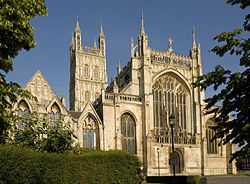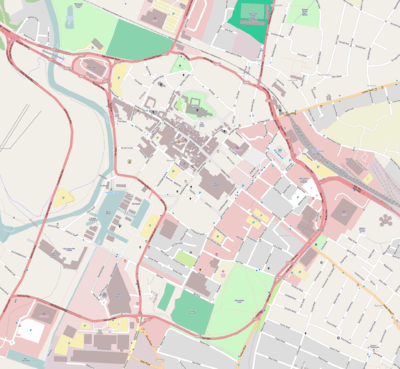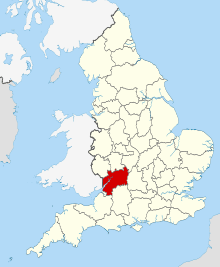Gloucester Cathedral
| Gloucester Cathedral | |
|---|---|
| Cathedral Church of St Peter and the Holy and Indivisible Trinity | |
 | |
 Gloucester Cathedral Shown within Gloucester | |
| 51°52′03″N 2°14′48″W / 51.8675°N 2.246667°WCoordinates: 51°52′03″N 2°14′48″W / 51.8675°N 2.246667°W | |
| Location | Gloucester, Gloucestershire |
| Country | England |
| Denomination | Church of England |
| Previous denomination | Roman Catholic |
| Website |
www |
| Architecture | |
| Style | Romanesque & Gothic |
| Years built | 1089–1499 |
| Specifications | |
| Length | 130m |
| Width across transepts | 43.9m |
| Height | 68.6m |
| Number of towers | 1 |
| Tower height | 68.6m |
| Administration | |
| Diocese | Gloucester (since 1541) |
| Province | Canterbury |
| Clergy | |
| Dean | Stephen Lake |
| Precentor | Neil Heavisides |
| Archdeacon | Jackie Searle |
| Laity | |
| Director of music | Adrian Partington |
Gloucester Cathedral, formally the Cathedral Church of St Peter and the Holy and Indivisible Trinity, in Gloucester, England, stands in the north of the city near the River Severn. It originated in 678 or 679 with the foundation of an abbey dedicated to Saint Peter (dissolved by King Henry VIII).
History
Foundations
Wardle records that in 1058 Ealdred, Bishop of Worcester at the time, rebuilt the church of St Peter.[1] The foundations of the present church were laid by Abbot Serlo (1072–1104). Walter Gloucester (d. 1412) the abbey's historian, became its first mitred abbot in 1381. Until 1541, Gloucester lay in the see of Worcester, but the separate see was then constituted, with John Wakeman, last abbot of Tewkesbury, as its first bishop. The diocese covers the greater part of Gloucestershire, with small parts of Herefordshire and Wiltshire. The cathedral has a stained glass window containing the earliest images of golf. This dates from 1350, over 300 years earlier than the earliest image of golf from Scotland.[2] There is also a carved image of people playing a ball game, believed by some to be one of the earliest images of medieval football.
Construction and architecture

The cathedral, built as the abbey church, consists of a Norman nucleus (Walter de Lacy is buried there), with additions in every style of Gothic architecture. It is 420 feet (130 m) long, and 144 feet (44 m) wide, with a fine central tower of the 15th century rising to the height of 225 ft (69 m) and topped by four delicate pinnacles, a famous landmark. The nave is massive Norman with an Early English roof; the crypt, under the choir, aisles and chapels, is Norman, as is the chapter house. The crypt is one of the four apsidal cathedral crypts in England, the others being at Worcester, Winchester and Canterbury.

The south porch is in the Perpendicular style, with a fan-vaulted roof, as also is the north transept, the south being transitional Decorated Gothic. The choir has Perpendicular tracery over Norman work, with an apsidal chapel on each side: the choir vaulting is particularly rich. The late Decorated east window is partly filled with surviving medieval stained glass. Between the apsidal chapels is a cross Lady chapel, and north of the nave are the cloisters, the carrels or stalls for the monks' study and writing lying to the south. The cloisters at Gloucester are the earliest surviving fan vaults, having been designed between 1351 and 1377 by Thomas de Cambridge.[3]
The most notable monument is the canopied shrine of King Edward II of England who was murdered at nearby Berkeley Castle (illustration below). The building and sanctuary were enriched by the visits of pilgrims to this shrine. In a side-chapel is a monument in coloured bog oak of Robert Curthose, eldest son of William the Conqueror and a great benefactor of the abbey, who was interred there. Monuments of Bishop Warburton and Dr Edward Jenner are also worthy of note.
Between 1873 and 1890, and in 1897, the cathedral was extensively restored by Sir George Gilbert Scott.
Misericords
The cathedral has forty-six 14th-century misericords and twelve 19th-century replacements by George Gilbert Scott. Both types have a wide range of subject matter: mythology, everyday occurrences, religious symbolism and folklore.
Clergy
- Dean – The Very Revd Stephen Lake (since 12 June 2011 installation)[4]
- Canon Precentor – The Revd Canon Neil Heavisides (1993-September 2015; additionally Acting Dean, 1 October 2010–May 2011)[5]
- Canon Pastor – The Revd Canon Celia Thomson (since 15 March 2003 installation)[6]
- Archdeacon of Gloucester (Canon Residentiary) – The Venerable Jackie Searle (since 12 September 2012 collation)
- Diocesan Canon (City Centre Rector) – The Revd Canon Nikki Arthy (since 2009)
- Director of Mission and Ministry (Canon Residentiary) – The Revd Canon Andrew Braddock (since 2 February 2013 installation)[7][8]
Music

Organ
Details of the organ from the National Pipe Organ Register
Organists
In 1582, Robert Lichfield is recorded as the organist of Gloucester Cathedral. Notable among the organists are composers and choral conductors of the Three Choirs Festival, Sir Arthur Herbert Brewer, Herbert Sumsion and John Sanders.
The Three Choirs Festival
An annual musical festival, the Three Choirs Festival, is hosted by turns in this cathedral and those of Worcester and Hereford in rotation.[9] The Three Choirs is the oldest annual musical festival in the world. Three Choirs Festival
Burials

- Robert Curthose, eldest son of William the Conqueror
- Edward II of England, seventh Plantagenet king of England (1307–1327).
- John Wakeman, last Abbot of Tewkesbury and first Bishop of Gloucester (1541–1550).
- James Brooks Bishop of Gloucester (1554–1558).
- Richard Cheyney, Bishop of Gloucester (1562–1579).
- John Bullingham, Bishop of Gloucester (1581–1598).
- William Nicholson Bishop of Gloucester (1660–1672).
- Martin Benson, Bishop of Gloucester (1734–1752).
- Richard Pate, landowner and Member of Parliament for Gloucester.
- Thomas Machen, mercer who was mayor of Gloucester three times and one time Member of Parliament for the city.
- Dorothea Beale, Principal of the Cheltenham Ladies' College, educational reformer and suffragist.
Film and TV location

- Harry Potter films
- Doctor Who
- In 2008, the Cathedral was used by BBC Wales as a location for the Doctor Who Christmas Special.
- The Hollow Crown
- The Cathedral was used as a filming location in BBC's series "The Hollow Crown" (an adaption of Shakespeare's Henry IV parts 1 and 2).[10]
- Wolf Hall
- Sherlock
Academic use
Degree ceremonies of the University of Gloucestershire and the University of the West of England (through Hartpury College) both take place at the cathedral.[14][15]
The cathedral is also used during school term-time as the venue for assemblies (known as morning chapel) by The King's School, Gloucester, and for events by the High School for Girls (Denmark Road, Gloucester), the Crypt Grammar School for boys and Ribston Hall High School.
Timeline

- 678-9 A small religious community was founded here in Saxon times by Osric of the Hwicce. His sister Kyneburga was the first Abbess.
- 1017 Secular priests expelled; the monastery given to Benedictine monks.
- 1072 Serlo, the first Norman abbot, appointed to the almost defunct monastery by William I.
- 1089 Foundation stone of the new abbey church laid by Robert de Losinga, Bishop of Hereford.
- 1100 Consecration of St. Peter’s Abbey.
- 1216 First coronation of King Henry III.
- 1327 Burial of King Edward II.
- 1331 Perpendicular remodelling of the quire.
- 1373 Great Cloister begun by Abbot Horton; completed by Abbott Frouster (1381–1412).
- 1420 West End rebuilt by Abbot Morwent
- 1450 Tower begun by Abbot Sebrok; completed by Robert Tully.
- 1470 Lady Chapel rebuilt by Abbot Hanley; completed by Abbot Farley (1472–98)
- 1540 Dissolution of Abbey
- 1541 Refounded as a Cathedral by King Henry VIII.
- 1616–21 William Laud holds the office of dean of Gloucester.
- 1649–60 Abolition of Dean and Chapter, reinstated by Charles II.
- 1735–52 Martin Benson, Bishop of Gloucester carried out major repairs and alterations to the cathedral.
- 1847–73 Beginning of extensive Victorian restoration work (Frederick S. Waller and Sir G. Gilbert Scott, architects).
- 1953 Major appeal for the restoration of the cathedral; renewed
- 1968 Cathedral largely re-roofed and other major work completed.
- 1989 900th anniversary appeal.
- 1994 Restoration of tower completed.
- 2000 Celebration of the novecentennial of the consecration of St Peter’s Abbey
See also
- Architecture of the medieval cathedrals of England
- English Gothic architecture
- List of cathedrals in the United Kingdom
Notes
- ↑ Wardle, Terry Heroes & Villains of Worcestershire 2010 The History Press, Stroud, Gloucestershire p. 10 ISBN 978-0-7524-5515-0
- ↑ "The first Golf record?". A Royal and Ancient Golf History video. Fore Tee Video. Retrieved 2009-01-16.
- ↑ Harvey, John (1978). The Perpendicular Style. Batsford. ISBN 0-7134-1610-6.
- ↑ Gloucester Cathedral – New Dean announced
- ↑ Gloucester Cathedral – Annual Report 2011
- ↑ Christ Church West Wimbledon – Information, Candlemas 2003
- ↑ "Church Times gazette". Church Times. 21/28 December 2012. p. 58. #7814. Check date values in:
|date=(help) - ↑ Gloucester Cathedral – Event Details, Diocesan Eucharist and Installation of Canon Andrew Braddock
- ↑ "Three Choirs Festival". Retrieved 2009-01-16.
- ↑ IT was a case of 'once more into the breach' for Gloucester Cathedral which has provided the backdrop for another star studded drama.
- ↑ The Stately Homes of Wolf Hall
- ↑ "Sherlock watch: Benedict Cumberbatch and Martin Freeman set for filming in Gloucester Cathedral". Gloucester Citizen. 22 January 2015. Retrieved 23 January 2015.
- ↑ "Sherlock stars back filming at Gloucester Cathedral today". Gloucester Citizen. 23 January 2015.
- ↑ "Information for the Ceremonies held at Gloucester Cathedral". University of Gloucestershire. Retrieved 2012-05-04.
- ↑ "Higher Education Graduation". Hartpury College. Retrieved 2012-05-04.
References
- Simmons, D A (1962). Who's who in music and musicians' international directory (4th. ed.). London: Burke's Peerage Ltd. OCLC 13309419. Published in America as Simmons, David (1962). Who's who in music and musicians' international directory (4th. ed.). New York: Hafner Publishing Company. OCLC 12923270.
External links
| Wikimedia Commons has media related to Gloucester Cathedral. |
| ||||||||||||||||||||||||||||||||||||||||||||||||||||

